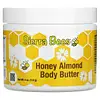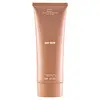What's inside
What's inside
 Key Ingredients
Key Ingredients

 Benefits
Benefits

 Concerns
Concerns

 Ingredients Side-by-side
Ingredients Side-by-side

Water
Skin ConditioningCetearyl Alcohol
EmollientCaprylic/Capric Triglyceride
MaskingCocos Nucifera Oil
MaskingHelianthus Annuus Seed Oil
EmollientGlycerin
HumectantButyrospermum Parkii Butter
Skin ConditioningGlyceryl Stearate
EmollientCetearyl Glucoside
EmulsifyingJojoba Esters
EmollientSimmondsia Chinensis Seed Oil
EmollientAloe Barbadensis Leaf Juice
Skin ConditioningPhytosteryl Oleate
Skin ConditioningSaccharide Isomerate
HumectantTocopherol
AntioxidantHoney
HumectantParfum
MaskingTetrasodium Glutamate Diacetate
Acacia Decurrens Flower Wax
EmollientXanthan Gum
EmulsifyingHelianthus Annuus Seed Cera
EmollientSodium Stearoyl Lactylate
EmulsifyingPhenoxyethanol
PreservativePolyglycerin-3
HumectantPhytosterols
Skin ConditioningAcacia Senegal Gum
MaskingTheobroma Cacao Seed Butter
EmollientMangifera Indica Seed Butter
Skin ConditioningHippophae Rhamnoides Fruit Extract
Skin ConditioningCamellia Sinensis Extract
AntioxidantEthylhexylglycerin
Skin ConditioningChamomilla Recutita Flower Extract
MaskingTheobroma Grandiflorum Seed Butter
Skin ConditioningSchinziophyton Rautanenii Kernel Oil
EmollientMoringa Oil/Hydrogenated Moringa Oil Esters
Skin ConditioningCitric Acid
BufferingSodium Citrate
BufferingCocos Nucifera Fruit Juice
EmollientWater, Cetearyl Alcohol, Caprylic/Capric Triglyceride, Cocos Nucifera Oil, Helianthus Annuus Seed Oil, Glycerin, Butyrospermum Parkii Butter, Glyceryl Stearate, Cetearyl Glucoside, Jojoba Esters, Simmondsia Chinensis Seed Oil, Aloe Barbadensis Leaf Juice, Phytosteryl Oleate, Saccharide Isomerate, Tocopherol, Honey, Parfum, Tetrasodium Glutamate Diacetate, Acacia Decurrens Flower Wax, Xanthan Gum, Helianthus Annuus Seed Cera, Sodium Stearoyl Lactylate, Phenoxyethanol, Polyglycerin-3, Phytosterols, Acacia Senegal Gum, Theobroma Cacao Seed Butter, Mangifera Indica Seed Butter, Hippophae Rhamnoides Fruit Extract, Camellia Sinensis Extract, Ethylhexylglycerin, Chamomilla Recutita Flower Extract, Theobroma Grandiflorum Seed Butter, Schinziophyton Rautanenii Kernel Oil, Moringa Oil/Hydrogenated Moringa Oil Esters, Citric Acid, Sodium Citrate, Cocos Nucifera Fruit Juice
Water
Skin ConditioningGlycerin
HumectantC15-19 Alkane
SolventTribehenin
EmollientHelianthus Annuus Seed Oil
EmollientTocopheryl Acetate
AntioxidantOctyldodecyl Neopentanoate
EmollientJojoba Esters
EmollientCetearyl Glucoside
EmulsifyingSunflower Seed Oil/Hydrogenated Sunflower Seed Oil Esters
EmollientHamamelis Virginiana Water
AstringentCetearyl Alcohol
EmollientRicinus Communis Seed Oil
MaskingUndecane
EmollientButyrospermum Parkii Butter
Skin ConditioningTerminalia Ferdinandiana Fruit Extract
AntioxidantNiacinamide
SmoothingChenopodium Quinoa Seed Extract
Skin ConditioningHibiscus Sabdariffa Flower Extract
Skin ConditioningMoringa Oleifera Seed Extract
Skin ConditioningChondrus Crispus Extract
Skin ConditioningCaffeine
Skin ConditioningAloe Barbadensis Leaf
MaskingTridecane
PerfumingSymphytum Officinale Leaf Extract
Skin ConditioningHydrogenated Castor Oil
EmollientAllantoin
Skin ConditioningCopernicia Cerifera Wax
Argania Spinosa Kernel Oil
EmollientCocos Nucifera Oil
MaskingVitis Vinifera Seed Oil
EmollientSodium Dehydroacetate
PreservativeAcacia Senegal Gum
MaskingXanthan Gum
EmulsifyingHyaluronic Acid
HumectantPropanediol
SolventXylitylglucoside
HumectantAnhydroxylitol
HumectantXylitol
HumectantOctyldodecanol
EmollientOctyldodecyl Xyloside
EmulsifyingPhenoxyethanol
PreservativeSorbitan Oleate Decylglucoside Crosspolymer
CleansingCitrus Paradisi Fruit Extract
Skin ConditioningCitrus Aurantium Dulcis Peel Extract
Emulsion StabilisingLavandula Angustifolia Flower/Leaf/Stem Extract
MaskingCucumis Melo Fruit Extract
Skin ConditioningVanilla Planifolia Fruit Extract
Skin ConditioningWater, Glycerin, C15-19 Alkane, Tribehenin, Helianthus Annuus Seed Oil, Tocopheryl Acetate, Octyldodecyl Neopentanoate, Jojoba Esters, Cetearyl Glucoside, Sunflower Seed Oil/Hydrogenated Sunflower Seed Oil Esters, Hamamelis Virginiana Water, Cetearyl Alcohol, Ricinus Communis Seed Oil, Undecane, Butyrospermum Parkii Butter, Terminalia Ferdinandiana Fruit Extract, Niacinamide, Chenopodium Quinoa Seed Extract, Hibiscus Sabdariffa Flower Extract, Moringa Oleifera Seed Extract, Chondrus Crispus Extract, Caffeine, Aloe Barbadensis Leaf, Tridecane, Symphytum Officinale Leaf Extract, Hydrogenated Castor Oil, Allantoin, Copernicia Cerifera Wax, Argania Spinosa Kernel Oil, Cocos Nucifera Oil, Vitis Vinifera Seed Oil, Sodium Dehydroacetate, Acacia Senegal Gum, Xanthan Gum, Hyaluronic Acid, Propanediol, Xylitylglucoside, Anhydroxylitol, Xylitol, Octyldodecanol, Octyldodecyl Xyloside, Phenoxyethanol, Sorbitan Oleate Decylglucoside Crosspolymer, Citrus Paradisi Fruit Extract, Citrus Aurantium Dulcis Peel Extract, Lavandula Angustifolia Flower/Leaf/Stem Extract, Cucumis Melo Fruit Extract, Vanilla Planifolia Fruit Extract
Ingredients Explained
These ingredients are found in both products.
Ingredients higher up in an ingredient list are typically present in a larger amount.
Acacia Senegal Gum has skin soothing, thickening, and formulation stabilizing properties. It comes from the Acacia tree that is native to sub-Saharan Africa.
This ingredient is also known as shea butter. It is an effective skin hydrator and emollient.
Emollients help soothe and soften your skin. It does this by creating a protective film on your skin. This barrier helps trap moisture and keeps your skin hydrated. Emollients may be effective at treating dry or itchy skin.
Shea butter is rich in antioxidants. Antioxidants help fight free-radicals, or molecules that may harm the body. It is also full of fatty acids including stearic acid and linoleic acid. These acids help replenish the skin and keep skin moisturized.
While Shea Butter has an SPF rating of about 3-4, it is not a sunscreen replacement.
Shea butter may not be fungal acne safe. We recommend speaking with a professional if you have any concerns.
Learn more about Butyrospermum Parkii ButterCetearyl alcohol is a mixture of two fatty alcohols: cetyl alcohol and stearyl alcohol. It is mainly used as an emulsifier. Emulsifiers help prevent the separation of oils and products. Due to its composition, it can also be used to thicken a product or help create foam.
Cetearyl alcohol is an emollient. Emollients help soothe and hydrate the skin by trapping moisture.
Studies show Cetearyl alcohol is non-toxic and non-irritating. The FDA allows products labeled "alcohol-free" to have fatty alcohols.
This ingredient is usually derived from plant oils such as palm, vegetable, or coconut oils. There is debate on whether this ingredient will cause acne.
Due to the fatty acid base, this ingredient may not be Malassezia folliculitis safe.
Learn more about Cetearyl AlcoholCetearyl Glucoside is a surfactant and emulsifier. It can be produced from synthetic of natural sources of cetearyl alcohol and glucose.
Emulsifiers help prevent ingredients from separating, such as oils and waters. It can also be used to enhance the texture of products.
As a surfactant, Cetearyl Glucoside helps during the cleansing process. By gathering all the dirt and oils, it allows these molecules to be washed away easily.
Learn more about Cetearyl GlucosideCocos Nucifera Oil is obtained from the kernels of the coconut fruit. In other words, this is coconut oil.
Coconut Oil is rich in fatty acids with lauric acid making up the majority of these. It also contains linoleic acid. Due to this high fatty acid content, coconut oil helps trap moisture and soften skin.
Despite being antibacterial, coconut oil may not be great for acne-prone skin. It is comedogenic and may clog pores. This ingredient may not be safe for malassezia or fungal acne.
Note: Coconut Oil should not replace your sunscreen for UV protection. Studies show it only blocks about 20% of UV.
This oil is non-volatile and has a light scent.
The term 'fragrance' is not regulated in many countries. In many cases, it is up to the brand to define this term. For instance, many brands choose to label themselves as "fragrance-free" because they are not using synthetic fragrances. However, their products may still contain ingredients such as essential oils that are considered a fragrance.
Learn more about Cocos Nucifera OilGlycerin is already naturally found in your skin. It helps moisturize and protect your skin.
A study from 2016 found glycerin to be more effective as a humectant than AHAs and hyaluronic acid.
As a humectant, it helps the skin stay hydrated by pulling moisture to your skin. The low molecular weight of glycerin allows it to pull moisture into the deeper layers of your skin.
Hydrated skin improves your skin barrier; Your skin barrier helps protect against irritants and bacteria.
Glycerin has also been found to have antimicrobial and antiviral properties. Due to these properties, glycerin is often used in wound and burn treatments.
In cosmetics, glycerin is usually derived from plants such as soybean or palm. However, it can also be sourced from animals, such as tallow or animal fat.
This ingredient is organic, colorless, odorless, and non-toxic.
Glycerin is the name for this ingredient in American English. British English uses Glycerol/Glycerine.
Learn more about GlycerinHelianthus Annuus Seed Oil is the oil derived from the seeds of a Sunflower. Sunflower seed oil is non-fragrant. It is an emollient, meaning it helps to soften the skin.
Sunflower seed oil contains many fatty acids. The fatty acids found in sunflower seeds include (from highest amount to least): linoleic acid, myristic acid, palmitic acid, stearic acid, arachidic acid, oleic acid, and linolenic acid.
These fatty acids help the skin create ceramides. Ceramides play a role in repairing the skin barrier.
Helianthus Annuus Seed Oil helps moisturize the skin. This in turn helps the skin look more rejuvenated and smoother.
Sunflowers are rich in vitamin E.
Historians believe Indigenous cultures of North America domesticated sunflowers before corn. Thus they relied on sunflower oil for a variety of uses. One such use is moisturizing skin and hair.
Sunflower seed oil may not be fungal acne safe. We recommend speaking with a professional if you have any concerns.
Learn more about Helianthus Annuus Seed OilJojoba Esters is a wax created from Jojoba oil. It is an emollient and film-forming ingredient. In bead form, it is an exfoliator.
This ingredient has high oxidative stability, meaning it doesn't break down when exposed to oxygen.
Its similarity to our skin's natural oils makes it a great emollient. Emollients help soften and soothe our skin by creating a barrier on top. This barrier helps trap moisture in, keeping skin hydrated.
It is created using either the hydrogenation or transesterification processes on jojoba oil.
Learn more about Jojoba EstersPhenoxyethanol is a preservative that has germicide, antimicrobial, and aromatic properties. Studies show that phenoxyethanol can prevent microbial growth. By itself, it has a scent that is similar to that of a rose.
It's often used in formulations along with Caprylyl Glycol to preserve the shelf life of products.
Water. It's the most common cosmetic ingredient of all. You'll usually see it at the top of ingredient lists, meaning that it makes up the largest part of the product.
So why is it so popular? Water most often acts as a solvent - this means that it helps dissolve other ingredients into the formulation.
You'll also recognize water as that liquid we all need to stay alive. If you see this, drink a glass of water. Stay hydrated!
Learn more about WaterXanthan gum is used as a stabilizer and thickener within cosmetic products. It helps give products a sticky, thick feeling - preventing them from being too runny.
On the technical side of things, xanthan gum is a polysaccharide - a combination consisting of multiple sugar molecules bonded together.
Xanthan gum is a pretty common and great ingredient. It is a natural, non-toxic, non-irritating ingredient that is also commonly used in food products.
Learn more about Xanthan Gum